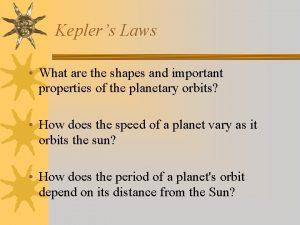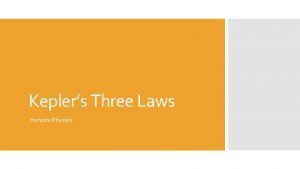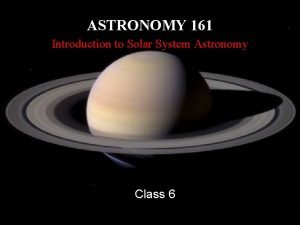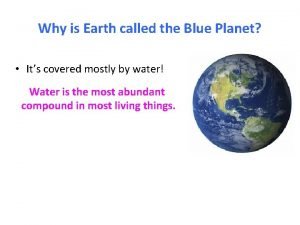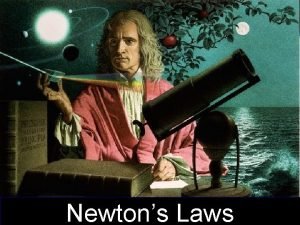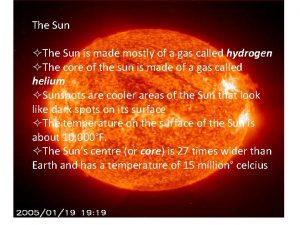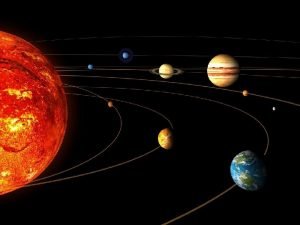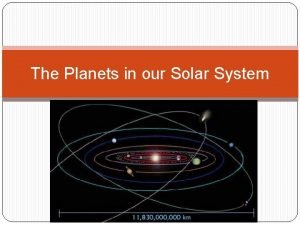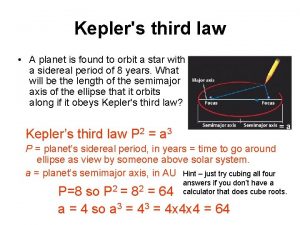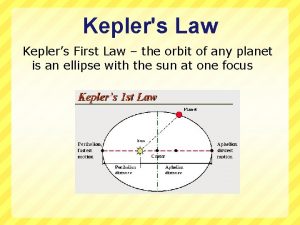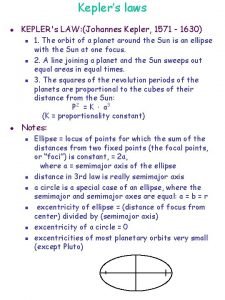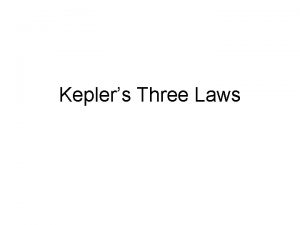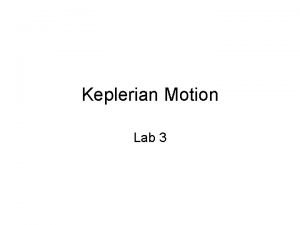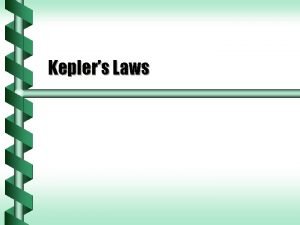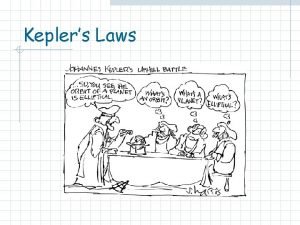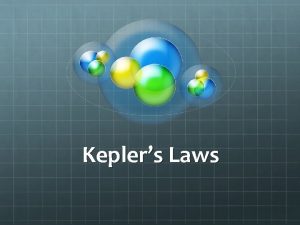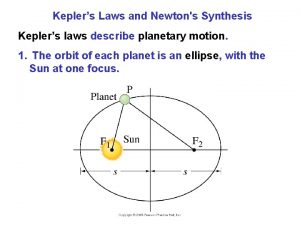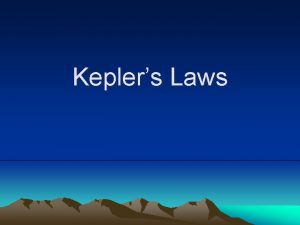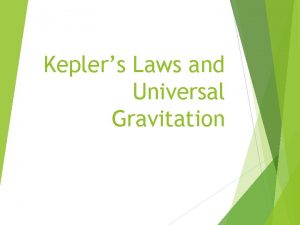Keplers third law A planet is found to














- Slides: 14

Kepler's third law • A planet is found to orbit a star with a sidereal period of 8 years. What will be the length of the semimajor axis of the ellipse that it orbits along if it obeys Kepler's third law? = a Kepler’s third law P 2 = a 3 P = planet’s sidereal period, in years = time to go around ellipse as view by someone above solar system. a = planet’s semimajor axis, in AU Hint – just try cubing all four answers if you don’t have a calculator that does cube roots. P=8 so P 2 = 82 = 64 a = 4 so a 3 = 4 x 4 x 4 = 64

Kepler's second law • In the following image, the amount of time it takes the planet to go from A to B is the same as the time it takes to go from C to D. The amount of ink that would be required to paint in each of the brown triangles is about equal because planet sweeps out equal area in equal time. Recall the discussion in lecture where I covered triangles with little squares to measure area.

Kepler's second law 2 • Suppose that an object was found to orbit the Sun, and that its path was an ellipse with eccentricity of 0. 5. If the planet always moved at the same speed, would it satisfy Kepler's second law? Choose the best answer of the four below. No, because when an object sweeps out equal areas in equal time, it must travel faster when it is closer to the planet.

Kepler's second law 3 • Suppose that the time between A and B was 1 month. What would the time be for the planet to go from C to D? Less than one month. As the planet moves closer to the sun, it travels faster. The distance between A and B is about the same as the distance between C and D, so it will take less time to go from C to D. (The area from Sun-A-B is more than Sun-C-D. ) d d

Mass and Weight • If you measured your weight with very high precision scale, would you see a difference between your weight at the top of a mountain versus at the bottom of the mountain? Select the best answer. • Yes, because the force that Earth exerts on me would be slightly less because I am slightly farther from it. So the scale spring will compress less and so a scale will register my weight as less. See the next slide.

Mass and Weight continued Mass m 1 r A spring Mass m 2 Weight is a number that tells you about how much this spring will compress. It depends on m 1 and r.

Mass and Weight 2 • If you measured your mass with very high precision scale, would you see a difference between your mass at the top of a mountain versus at sea level? Select the best answer. • No. My mass would not change because the number of atoms and molecules in me does not change. Note that the periodic table, which lists intrinsic properties of the elements such as number of electrons and protons, uses “atomic mass”.

Newton's Law of Gravity • Newton's Law of Gravity is • This equation states that if the distance between two objects increases by a factor of three, the force they exert on each other decreases by a factor of nine. For example, if r goes from 2 to 2 x 3, the force equation changes from to

Newton's Law of Gravity 2 • Newton's Law of Gravity is • This equation states that if the mass of each object increased by a factor of two, the force that object 1 exerts on object 2 increases by a factor of four.

Newton and Kepler • In class, we came up with an equation that related a planet's orbital speed, v, with its distance from the sun, r given the sun had mass m 1 • Why is this equation consistent with Kepler's second law? According to Kepler's second law, the farther the planet is from the sun, the slower it moves. According to this equation, the larger r is, the smaller v is.

Tides • In the following figure we are assuming that Earth has two moons. If both moons are the same distance from Earth, which moon has a larger mass? Moon 1. If both moons are the same distance, the one with the larger mass will exert greater tidal forces. Although the sun has a very large mass, it is very far away, which is the reason it has a smaller tidal force than the moon.

Gravity • In the following figure, at which position would the force of gravity due to Earth be about the same, but in opposite direction, as the force of gravity due to Mars? Note that Mars has a smaller mass than Earth. • At 2, the distance between Mars and ship is equal to distance between Earth and ship. Earth has a larger mass, so it will pull harder to the left. If you move to the right (near 3), (a) the distance from Earth to the ship will increase and so the force of Earth will decrease and (b) the distance from Mars to the ship will decrease and so the force of Mars on the ship will increase. At some point near 3, the forces of Earth to the left will balance the force of Mars to the right.

Gravity cont. • In the following figure, at which position would the force of gravity due to Earth be about the same, but in opposite direction, as the force of gravity due to Mars? Note that Mars has a smaller mass than Earth. • At 2, the distance between Mars and ship is equal to distance between Earth and ship. Earth has a larger mass, so it will pull harder to the left. If you move to the right (near 3), (a) the distance from Earth to the ship will increase and so the force of Earth will decrease and (b) the distance from Mars to the ship will decrease and so the force of Mars on the ship will increase. At some point near 3, the forces of Earth to the left will balance the force of Mars to the right.

Debating students • Given that Earth is much larger and more massive than the Moon, how does the strength of the gravitational force that the Moon exerts on Earth compare to the gravitational force that Earth exerts on the Moon? Student 1: I thought that whenever one object exerts a force on the second object, the second object also exerts a force that is equal in strength, but in the other direction. So even if Earth is bigger and more massive than the Moon, they still pull on each other with a gravitational force of the same strength, just in different directions. Student 2: I disagree. I said that Earth exerts the stronger force because it is way bigger than the Moon. Because its mass is bigger, the gravitational force Earth exerts has to be bigger too. I think that you are confusing Newton’s third law with the law of gravity. Which student is correct? Student 1. Newton’s third law says that when one object exerts a force on another object the other object exerts a force that is equal but in the opposite direction. Also, Newton’s law of gravity says that the force between two objects depends on the mass of both objects. If I push on someone that is the same size as me, he will react by falling backward, and I will fall backward as well. We both experienced the same force, so we both react by falling back in the same way. If I push on someone much larger, I fall back much more and he barely moves. I experienced the same force as he did, but because he has more mass, he reacted much less. Newton’s law of gravity
 Keplers law
Keplers law Newton's first law and second law and third law
Newton's first law and second law and third law Newton's first law and second law and third law
Newton's first law and second law and third law Keplers laws
Keplers laws Keplers three laws
Keplers three laws Keplers phase funnel
Keplers phase funnel Paragraph about earth
Paragraph about earth Cosa afferma la legge di gravitazione universale
Cosa afferma la legge di gravitazione universale What is the sun made of
What is the sun made of Whats the third planet from the sun
Whats the third planet from the sun Whats the fifth planet from the sun
Whats the fifth planet from the sun Cavity classification
Cavity classification Blacks classification
Blacks classification Boyle's law charles law avogadro's law
Boyle's law charles law avogadro's law Avogadro's law constants
Avogadro's law constants



